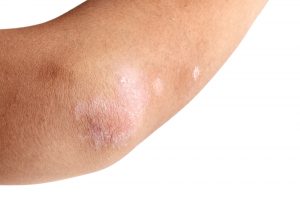All about Psoriatic arthritis, a chronic joint inflammation
People who suffer from psoriatic arthritis do not have just one, but two diseases. This syndrome consists of a skin condition (psoriasis) and a chronic joint inflammation (arthritis). An estimated 15 to 20 percent of patients with psoriasis also develop this form of arthritis. However, this form of inflammatory rheumatism is somewhat milder than rheumatoid arthritis. Patients with psoriatic arthritis usually only experience inflammation in the small joints in the fingers and toes, or only the knees. While rheumatoid arthritis usually also affects several larger joints.
More about psoriasis
This skin condition occurs in about 2% of people in the United States and United Kingdom. It is a chronic inflammatory disease. The immune system is overactive and attacks the healthy cells of the skin. As a result, the formation of too many skin cells occurs too fast. Local redness, strong peeling and itchiness occur, usually on the outside of the elbows, knees and scalp. Deviations to nails may also occur. This skin disease – which is absolutely non-contagious – can develop at any age, but occurs mainly in adults. We call this condition psoriatic arthritis when joint issues occur with psoriasis.
What is the cause of psoriatic arthritis?
Scientists have not yet been able to determine the cause of this disease. However, it is clear that it is an autoimmune disease. This is the collective name for a group of disorders. This means the body produces antibodies that attack its own tissue which interfere with regular bodily processes. In psoriatic arthritis, certain white blood cells – T lymphocytes – are overactive. Researchers have found extreme amounts of these abnormal cells in the inflamed joints and skin. Additionally, it is believed that a major role in the development of psoriatic arthritis is heredity. This means that this condition may occur in multiple members of the same family.
What are the symptoms of psoriatic arthritis?
In addition to red spots, peeling and itchiness of the skin, people suffer from inflammation in the fingers and toes. This causes pain and stiffness in these joints and you may experience less mobility in the fingers. Writing or turning a lid of a jar is therefore more difficult. Inflammation of toes or knees may hurt for example when walking. The pain can keep you from sleep at night. This may result in fatigue. Some patients also suffer from dry eyes, which may cause eye inflammation. Drops containing artificial tears can then help. In 20 to 30 percent of people with psoriatic arthritis, there is also an inflammation of the spine.
How do doctors diagnose psoriatic arthritis?

How do you treat psoriatic arthritis?
Those who suffer from this condition will need to consult with two different specialists. The dermatologist treats the psoriasis. And for joint inflammation, you go to the GP or rheumatologist. Full recovery is hard to achieve. However, a timely treatment can significantly reduce the symptoms. The dermatologist will prescribe drugs to inhibit the accelerated cell division and relieve the itching. Light therapy can also help. The GP or rheumatologist can treat the arthritis with painkillers and inflammatory inhibitors.
Green-lipped mussel in psoriatic arthritis
The idea of using Liquid Green lipped Mussel to reduce the symptoms of arthritis psoriatic is definitely interesting. After all, this shellfish from New Zealand contains a wide range of Omega-3 fatty acids and furan fatty acids. It is known that these fatty acids have anti-inflammatory action. Therefore, more and more people with osteoarthritis and arthritis use a supplement based on Green-lipped mussel.
In New Zealand, such agents are also recommended for patients with psoriasis. Not strange, because this skin condition is also caused by inflammation as mentioned above. The powerful Omega-3 fatty acids from Green-lipped mussel could therefore also have an effect on the skin in psoriasis. However, we have few experiences with Green-lipped mussel in psoriatic arthritis. It may be worthwhile to treat with liquid Green-lipped mussel if you suffer from psoriatic arthritis. Foundation ‘Moving Without Pain’ then would like to know what the results are.
I already have experience with this and I would like to share this!

Share this page
Tweet

Download for free the booklet ‘Moving without pain’ with a retail value of $6.75 / £4.95.
Any questions? Please feel free to contact us. Contact us.






